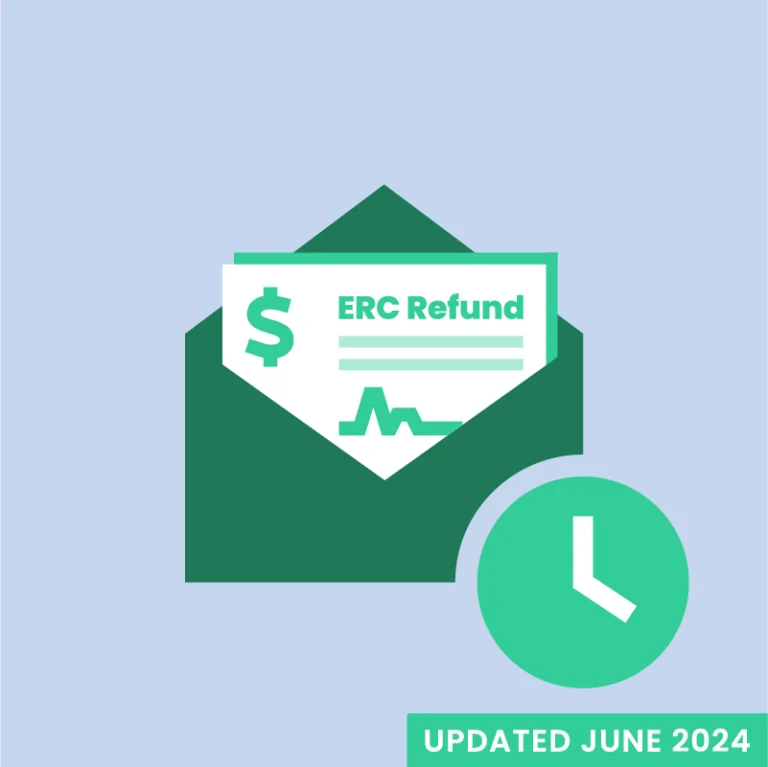On August 8, 2024, the Internal Revenue Service (IRS) announced it would begin processing Employee Retention Credit (ERC) claims received during the moratorium period between September 14, 2023, and January 31, 2024. This announcement is welcome news for some businesses whose ERC claims have gone unacknowledged while in the agency’s queue. The catch? More ERC claims will be rejected under intensified scrutiny, and the moratorium will continue.
Today, the tide is starting to turn on the Employee Retention Credit program. This effort will continue and intensify in the months ahead.
Furthermore, the IRS announced it would be reopening its Voluntary Disclosure Program (VDP) through November 22, 2024.
Continue reading to learn about the biggest takeaways from the IRS’s recent announcements, the facts and circumstances surrounding the ERC program, and what all of it means for business owners.
Background of the ERC Tax Credit and IRS Moratorium
The ERC tax credit was first introduced in March 2020 under the $2.2 trillion Coronavirus Aid, Relief, and Economic Security Act (CARES Act). It was a refundable tax credit meant to encourage employers to retain employees when facing revenue losses and government-mandated shutdowns during the COVID-19 pandemic.
The idea was simple, government payments would offset employers’ labor costs and restore some of their revenues. That, in turn, would help combat a surge in unemployment. But policymakers never expected the cost of the ERC to exceed $85 billion due to the relatively low number of applications initially filed. Four years later, more than $232 billion in ERC refunds have been processed, and many more are still awaiting the IRS’s attention.
The IRS believes ERC promoters are to blame, and the agency has gone to great lengths to deter their advertising efforts, as well as combat overstated and potentially fraudulent claims. One example is the IRS’s ERC moratorium, which was first announced on September 14, 2023, and was supposed to end in December 2023. However, 11 months later, the IRS’s ERC moratorium is still active for claims received after January 31, 2024.
Accomplishments During the IRS ERC Moratorium
- Digitization of ERC Claims and Early Findings. The IRS digitized more than one million ERC claims from its pre-moratorium backlog, representing approximately $86 billion, as of June 20, 2024. Based on its early analysis, the agency contends that 10-20% of these claims show a high risk of errors, 60-70% show an unacceptable risk of errors, and 10-20% show a low risk of errors.
- ERC Claims Processed and Disallowed. The IRS processed 28,000 pre-moratorium ERC claims valuing $2.2 billion and disallowed 14,000 valuing $1 billion in the nine months between September 2023 and June 2024. More recently, the IRS announced that 28,000 additional disallowance letters had been sent to ERC claimants in the weeks preceding August 8, 2024.
Note: There have been reports from the tax professional community that disallowances were issued to valid ERC claimants and that some letters inadvertently omitted a paragraph explaining the appeal process. The IRS has acknowledged the errors and assured that less than 10% of disallowances were wrongfully issued and that the omitted language will be mailed out to those affected.
- Rate of New ERC Claims Per Week. The IRS maintains that it receives 17,000 new ERC claims per week, a marked decline from 45,000 per week last Fall.
- ERC Withdrawal Program. The IRS’s ERC Withdrawal Program, which is still active, allows employers to retract their ERC claims before they’re processed, effectively treating them as if they were never filed. More than 7,300 entities have withdrawn their ERC claims worth $677 million as of August 8, 2024.
- ERC Voluntary Disclosure Program. The first iteration of the IRS’s ERC VDP, which ended on March 22, 2024, allowed employers to repay their ERC refund at a discounted rate of 80%. Employers retained the remaining 20% of their refund plus any interest received. More than 2,600 applications for the VDP were submitted, worth $1.09 billion, while the program was active.
- ERC Criminal Investigations. IRS Criminal Investigation (ICI) has launched 460 criminal cases as of July 1, 2024, representing almost $7 billion. Of those 460 investigations, 37 have resulted in federal charges, with 17 convictions and nine sentencings with an average sentence of 20 months.
- ERC Promoter Investigations. The IRS continues to gather information about third-party tax preparers and promoters it suspects of abuse in the hope that civil and criminal charges may eventually be pursued. The IRS reports that its Office of Promoter Investigations has received hundreds of referrals as of August 15, 2024.
- ERC Audits. The IRS states that thousands of ERC audits are underway as of August 15, 2024.
Revision of the IRS ERC Moratorium Period
The IRS has revised the ERC moratorium’s cutoff date and will begin processing claims received between September 14, 2023, and January 31, 2024. However, the agency has not committed to a timeline for this period, and the moratorium remains in effect for ERC claims received after.
The IRS chose January 31, 2024, to preserve the prospect of the Tax Relief for American Families and Workers Act (TRAFWA) becoming law. The TRAFWA made it through the House in January but later stalled in the Senate. This legislation would have sunsetted the ERC program early, extended the IRS’s assessment period from five to six years, and empowered the agency with more authority to penalize ERC promoters and fraudsters.
Prioritization of Low-Risk ERC Claims
The IRS will prioritize the processing of 50,000 valid ERC claims, with payments expected to begin going out in September. The agency will begin working on a second batch of low-risk ERC claims this Fall.
Reopening of the ERC Voluntary Disclosure Program
The IRS has reopened its ERC VDP through November 22, 2024. The program now allows businesses to repay their ERC refund with an 85% discount while retaining the remaining 15% and any interest received for the 2021 tax year. ERC refunds received for the 2020 tax year are ineligible for disclosure and repayment.
Plans to Issue Recapture Letters
The IRS plans to mail up to 30,000 new reversal and recapture letters this Fall for ERC refunds it believes were paid out improperly, representing more than $1 billion and comprising mainly 2021 quarters. The IRS will reclaim balance adjustments through its standard assessment and collection procedures.
Recipients are unable to apply for the ERC VDP for the calendar quarter their letter references.
Takeaways for Businesses Awaiting Their ERC Refund
It’s important that business owners consider the context of the IRS’s handling of ERC claims and the statistics they’re reporting. The IRS is incentivized to encourage businesses to participate in its ERC Withdrawal Program and VDP and to discourage businesses from submitting new ERC claims. More than 5.1 million ERC claims have been submitted for refunds, including the 3.6 million processed and the 1.5 million still awaiting the agency’s attention. ERC “fraud” has become common rhetoric. But ICI is pursuing 460 criminal investigations of potential ERC fraud — representing less than one percent of the total ERC claims submitted.
The IRS has committed to processing an initial batch of 50,000 low-risk ERC claims from its pre-moratorium backlog and a second batch this Fall. Business owners shouldn’t expect the agency to begin working on additional ERC claims until 2025. Delays in ERC refunds will continue, and the agency’s backlog of unprocessed ERC claims will likely get bigger. Bear in mind that the IRS is not legally obligated to issue businesses’ ERC refunds within a specified amount of time.
Ways Businesses Can Expedite Their ERC Refund
Contact the Taxpayer Advocate Service
The Taxpayer Advocate Service (TAS) is an independent organization within the IRS that has served a critical role in prioritizing and expediting ERC claims from businesses in need. Businesses may call the TAS at +1 (877) 777-4778.
Sue for Your ERC Refund
Section 6532 of the Internal Revenue Code (IRC) allows taxpayers to file a lawsuit for their refund in federal court if the IRS has failed to process their claim within 6 months or has provided a notice of disallowance.
Businesses should consult a seasoned tax attorney to determine whether this option is appropriate.
Apply for an ERC Loan or ERC Buyout
An ERC loan or ERC buyout will be the best way to expedite unprocessed refunds for most businesses. 1st Capital Financial is the industry leader in ERC funding and has been helping businesses advance their refunds since the program’s inception. We encourage you to submit an ERC Financing Form online or call us to learn more.
Implications of the Chevron Ruling for the IRS and ERC
On June 28, 2024, the U.S. Supreme Court overturned the 1984 Chevron doctrine, effectively ending a 40-year practice of “Chevron deference.” Chevron deference would typically require courts to defer to agencies, such as the IRS, when interpreting ambiguous federal law. The Court’s decision is relevant to the ERC program because the IRS is using its sub-regulatory guidance, predominately Notice 2021-20, to assess claimants’ eligibility. Many of the IRS’s eligibility criteria and record-keeping requirements do not appear in the ERC statute enacted by Congress. The IRS is treating notices like 2021-20 as the definitive word for explicating the ERC statute, with the agency’s counsel even referencing them as operative law in legal memoranda.
This recent development is nuanced but not in the IRS’s favor. ERC claimants and ERC promoters have already filed lawsuits citing notices like 2021-20 as unenforceable.
Final Thoughts on the Latest IRS ERC Announcements
While the day-to-day hardships of the COVID-19 pandemic are behind us, many of the economic challenges are still burdening small businesses. The ERC tax credit continues to be a lifeline for those struggling in the post-pandemic era. Unfortunately, the IRS’s efforts to pursue ERC promoters and fight ERC fraud have come at the cost of small businesses with legitimate claims. The IRS’s latest ERC announcements are a step forward but mean little to most businesses whose ERC refunds will remain unprocessed for the foreseeable future.
Businesses that have not filed an ERC claim have until April 15, 2025, to do so for the 2021 tax year. Businesses awaiting ERC refunds may consider an ERC loan or an ERC buyout with 1st Capital Financial.
Skip IRS Refund Delays With ERC Bridge Financing




